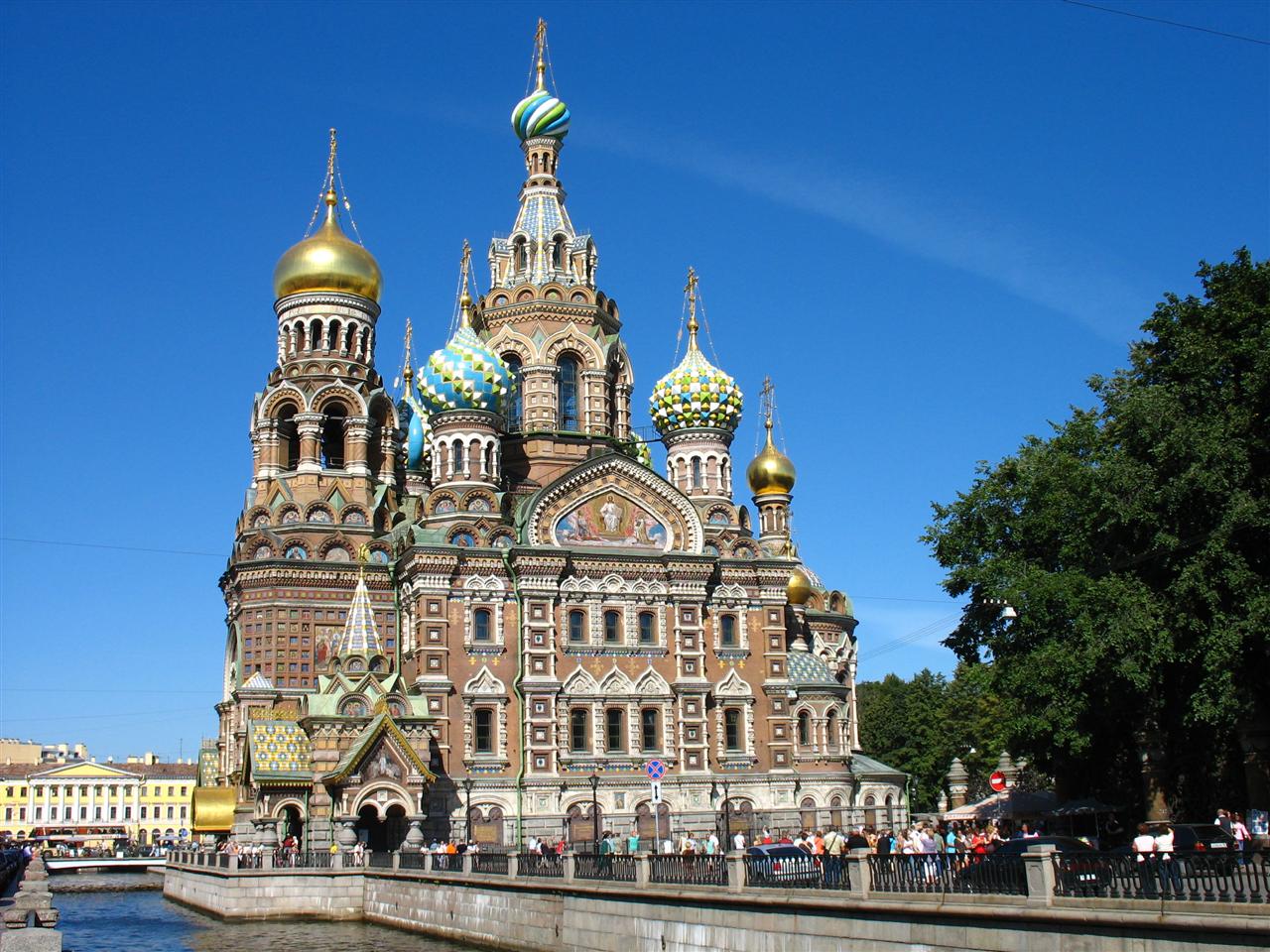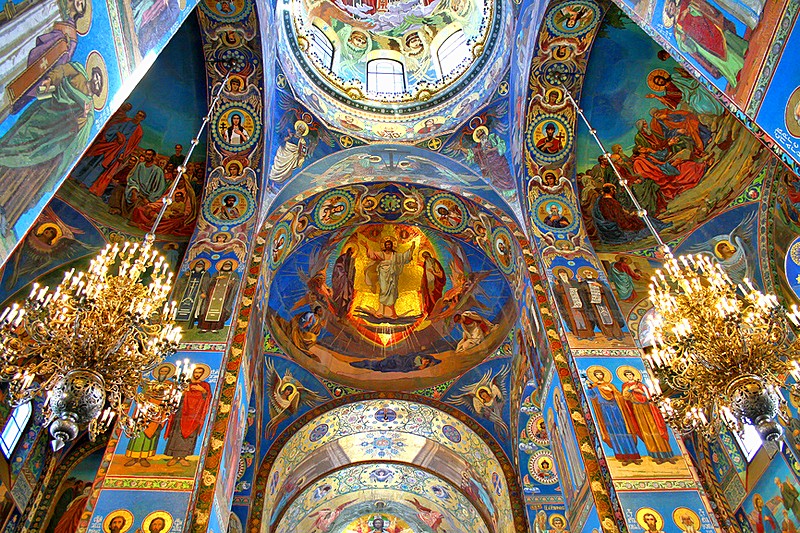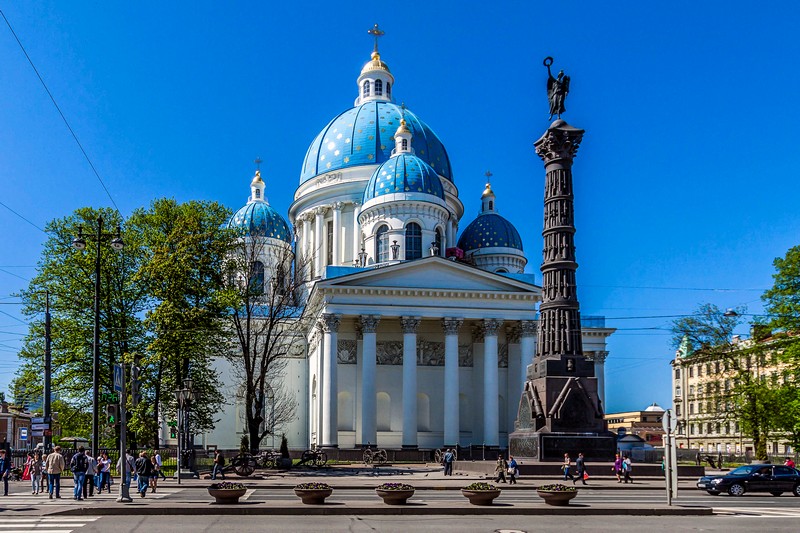Back to archive Among the most important attractions (or, everyone’s favorite Russian word, достопримечательности) in Saint Petersburg are its cathedrals and churches, each with a different style and story. Read more about five of the most important cathedrals in the city.
Among the most important attractions (or, everyone’s favorite Russian word, достопримечательности) in Saint Petersburg are its cathedrals and churches, each with a different style and story. Many of the cathedrals are open as museums and charge a small entrance fee; others still operate as places of worship and are free to enter. Out of respect, women should cover their heads with a scarf or shawl inside Orthodox churches and cathedrals, and men should remove their hats.
Kazan Cathedral (Казанский собор)
Built: 1801-1811
Modeled on Saint Peter’s Basilica in Rome, the Kazan Cathedral is one of the largest churches is all of Russia. It is named after the icon of Our Lady of Kazan which it housed until the 1930s.
Many attributed the Russian victory over Napoleon in the War of 1812 to the miraculous powers of Our Lady of Kazan, since the Russian army commander Mikhail Kutuzov had asked her for protection. Following the war, the Kazan Cathedral became a memorial to this victory. Kutuzov was buried there in 1813 and captured enemy banners were displayed in the cathedral.
The cathedral was closed for services by the Bolsheviks in 1928 and housed the Museum of the History of Religion and Atheism. In 1990, the museum’s name was changed to the State Museum of the History of Religion, and it is still open to the public, displaying religious artifacts from around the world. Part of the cathedral again functions as a place of worship with regular services.
St. Isaac’s Cathedral (Исаакиевский собор)
Built: 1818-1858
Dedicated to St. Isaac, on whose feast day Peter the Great was born, St. Isaac’s Cathedral was originally the main cathedral of Saint Petersburg. It is a good example of 19th century neo-Classical architecture. Its façades are decorated with sculptures and the interior with impressive colorful mosaics and paintings. It was closed as a church in the 1930s and reopened as a museum.
On a clear day, the top of the cathedral is the best view of the city if you’re willing to climb the 262 steps up to the colonnade (колоннада). During the period of Saint Petersburg’s “White Nights,” the colonnade is open to visitors until 4am.
Church of the Savior on Spilled Blood (Спас-на-крови)
Built: 1883-1907
This cathedral gets its name – which is sometimes translated as “Church on the Blood” or “Church of the Resurrection of Jesus Christ” – from being built on the spot where Emperor Alexander II was fatally wounded in 1881. Emperor Alexander III built the church in memorial of his father. Displeased with the European influence on Saint Petersburg, Alexander III modeled the church on the Russian cathedrals of the 16th and 17th centuries, in stark contrast to the surrounding architecture.
The church was looted following the Revolution and was heavily damaged in the Siege of Leningrad during World War II, but with funds from St. Isaac’s Cathedral museum, Church of the Savior on Spilled Blood was carefully restored and reopened in 1997. The interior is especially worth visiting, containing over 7500 square meters of colorful mosaics.
Smolny Cathedral (Смольный собор)
Built: 1748-1761
Smolny Cathedral was originally intended to be the church of a convent for Elizabeth, the daughter of Peter the Great, who decided to become a nun after not being allowed to take over the thrown. After Ivan VI was removed in a coup d’etat in 1741, however, Elizabeth was offered the thrown and gladly accepted it. She continued to fund the Smolny Convent during her reign.
The building was designed by the Italian architect Francesco Bartolomeo Rastrelli, who also designed many of the region’s other famous buildings, including the Winter Palace, Peterhof Palace, and Catherine Palace in Tsarskoe Selo.
This design is unusual in that it lacks a single facade, but looks impressive from any angle. Very little of its original interior is preserved, as it was looted, like many other churches and cathedrals, after the Revolution. Today the cathedral is used for concerts and art exhibitions rather than as a place of worship.
The Trinity Cathedral (Троицкий собор)
Built: 1828-1835
While attending Derzhavin Institute, you’ll likely walk past this cathedral several times a day! It was at this cathedral that Dostoevsky married his second wife, Anna Snitkina in 1867.
Trinity Cathedral was originally the regimental church of the Izmailovsky Regiment, who moved from near Moscow to Saint Petersburg when it became the capital of the Russian Empire. In 1733, a field tent was consecrated on the site of the future cathedral as a church for the soldiers of this regiment, and in the 1750s a wooden church was constructed there. The wooden church was damaged during a flood of 1824 and the cathedral built in its place was consecrated in 1835. The cathedral is a good example of Empire design of Neoclassical architecture.
In front of the cathedral, stands a monument to the victory of the Russo-Turkish War (1877-78). The original monument was put up in 1886 and was made from 140 cannon barrels used during the war, as well as guns and other pieces of artillery that were taken from the Turkish army. In the 1930s, the monument was removed overnight, presumably because the Soviet Union was on friendly terms with Turkey. The monument was restored recently.
The interior was once lavishly decorated in gold, but most of it was looted in the 1930s. Today, the inside of the cathedral remains relatively bare. The main dome was destroyed in a fire in 2006, but has since been carefully restored.











